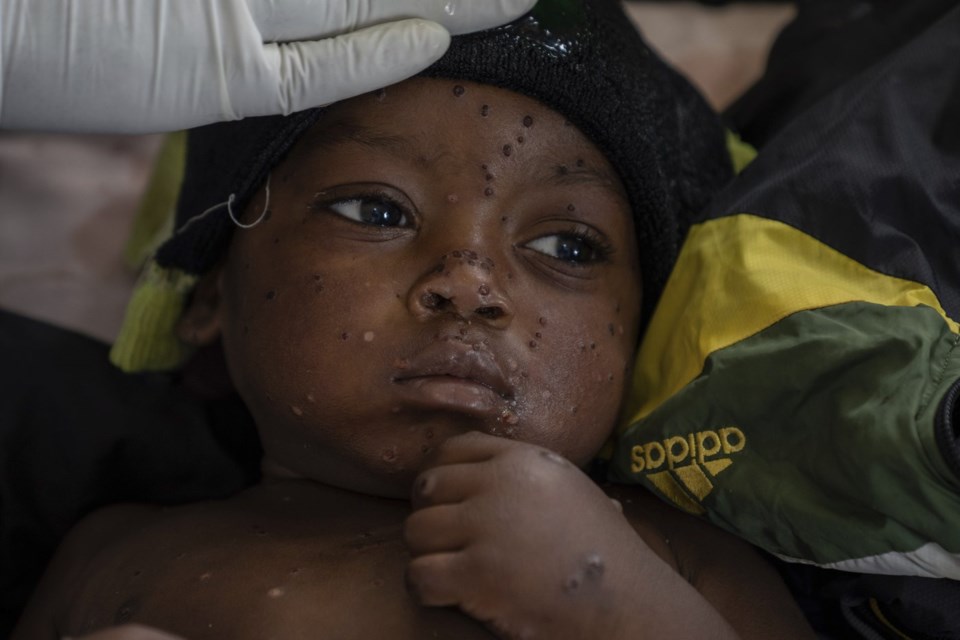GOMA, Congo (AP) ŌĆö Some health officials say cases in Congo appear to be ŌĆ£stabilizingŌĆØ ŌĆö a possible sign that the main epidemic for which the World Health Organization made a in August might be on the decline.
In recent weeks, Congo has reported about 200 to 300 lab-confirmed mpox cases every week, according to WHO. ThatŌĆÖs down from nearly 400 cases a week in July. The decline is also apparent in , the mining city in the eastern part of Congo where the new, more infectious variant of mpox first emerged.
But the U.N. health agency acknowledged Friday that only 40% to 50% of suspected infections in Congo were being tested ŌĆö and that the virus is continuing to spread in some parts of the country and elsewhere, including Uganda.
While doctors are encouraged by the drop in infections in some parts of Congo, it's still not clear what kinds of physical contact is driving the outbreak. Health experts are also frustrated by the low number of vaccine doses the central African nation has received ŌĆö 265,000 ŌĆö and say that delivering the vaccine to where it's needed in the sprawling country is proving difficult. WHO estimates 50,000 people have been immunized in Congo, which has a population of 110 million.
Scientists also say there needs to be an urgent, to halt mpox's spread and avoid further , like the one detected earlier this year in Congo after months of low-level circulation.
ŌĆ£If we miss this opportunity, the likelihood of another significant outbreak increases substantially,ŌĆØ said Dr. Zakary Rhissa, who heads operations in Congo for the charity Alima.
So far this year, there have been roughly 43,000 suspected cases in Africa and more than , mostly in Congo.
ŌĆ£WeŌĆÖve seen how past outbreaks, such as the one in Nigeria in 2017, can lead to larger global events if not effectively contained,ŌĆØ he said. The 2017 epidemic ended up leading to the 2022 that affected more than 100 countries.
Rhissa said the decline in cases in Kamituga ŌĆö where mpox initially spread among and miners ŌĆö is an opening to put more programs in place for vaccination, surveillance and education.
Georgette Hamuli, an 18-year-old sex worker, hadnŌĆÖt been aware of mpox until immunization teams arrived last week in the poor neighborhood where she works in Goma, the biggest city in eastern Congo.
ŌĆ£They told us we're highly exposed to the the risk of infection,ŌĆØ she said. ŌĆ£We insist on condoms with our clients, but some refuse ... if they donŌĆÖt want to use a condom, they double the amount they pay.ŌĆØ
Hamuli said she and other friends who are sex workers each received 2,000 Congolese francs ($0.70) from a charity to get vaccinated against mpox ŌĆö but it wasnŌĆÖt the money that swayed her.
ŌĆ£The vaccine is also necessary," she said. "I think weŌĆÖre now protected.ŌĆØ
The Africa Centers for Disease Control and Prevention has estimated Congo needs at least 3 million mpox vaccines to stop the virus, and another 7 million for the rest of Africa. So far, WHO and partners have allocated 900,000 vaccines to nine African countries affected by mpox and expect 6 million vaccines to be available by the end of this year.
Mpox epidemics in Burundi, Kenya, Rwanda and Uganda had their origins in Congo, and a number of cases in travelers have also been identified in Sweden, Thailand, Germany, India and Britain.
Fewer than half of the people who are most at risk in Congo have been vaccinated, according to Heather Kerr, Congo director for the the International Rescue Committee.
ŌĆ£We only have a tiny amount of vaccines, and nothing for the kids,ŌĆØ she said.
The vaccines for Congo are largely coming from donor countries like the U.S and through UNICEF, which mainly uses taxpayer money to buy the shots.
ŌĆ£WeŌĆÖre getting a charitable approach where we only see very small donations of vaccines to Africa,ŌĆØ said Dr. Chris Beyrer, director of the Global Health Institute at Duke University. ŌĆ£What we need is a public health approach where we immunize populations at scale.ŌĆØ
Drugmaker Bavarian Nordic, which makes the most widely used mpox vaccine, said it would sell shots destined for Africa at the lowest price possible.
The advocacy group Public Citizen published an analysis showing that UNICEF paid $65 per dose of the Jynneos mpox vaccine made by Bavarian Nordic, far higher than nearly all other vaccines used in public health programs.
Dr. Salim Abdool Karim, an infectious diseases expert at South AfricaŌĆÖs University of KwaZulu-Natal, said mpox outbreaks typically peak and disappear quickly because of how the virus spreads. This time, however, he said there are two complicating factors: the virusŌĆÖ transmission via sex and the continued spillover from infected animals.
ŌĆ£WeŌĆÖre in new territory with mpox this time,ŌĆØ he added. ŌĆ£But weŌĆÖre never going to solve this until we vaccinate most of our people.ŌĆØ
____
Cheng reported from London.
___
The Associated Press Health and Science Department receives support from the Howard Hughes Medical InstituteŌĆÖs Science and Educational Media Group. The AP is solely responsible for all content.
Maria Cheng And Ruth Alonga, The Associated Press



